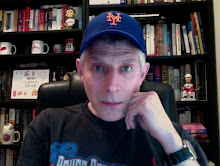THIRD PERIOD, GAME SIX of the 2013 Stanley Cup Finals: With 77 seconds left, the home team Boston Bruins -- trailing three games to two -- led the Chicago Blackhawks, 2-1.
It was win or go home time for Boston. Win and go home for Chicago.
Seventy-eight seconds later, the Blackhawks were Stanley Cup champions.
 |
| Extra! Extra! Extra! June 16, 2015 |
They potted two goals in 18 seconds, each by a man who was for all intents and purposes an x-factor, a replaceable spare part for a star-heavy juggernaut that would capture the cup three times in six years, a championship hat trick.
Bagging the tying goal at 18:44 was Bryan Bickell, a bottom six winger who'd netted nine goals in a lockout-shortened 48-game season, assisted on the scoresheet by future Hall of Famers Jonathan Toews and Duncan Keith, and off the sheet by the third star in that constellation, winger Patrick Kane.
Starting deep in their own zone, Keith corralled a loose puck and dropped it to Kane. He carried it up ice facing all five skating Bruins, flowed through three of them, broke to his left and fired a shot that B's netminder Tuukka Rask deflected to his blocker-side corner.
There the stars went to work digging out the puck, from Kane to Keith to Toews who spotted Bickell just outside the blue paint. With a perfect pass through the skates of towering Boston d-man Zdeno Chara the puck was on Bickell's stick, then behind Rask and in the net.
Tie game.
The Bruins, who had won the cup just two years earlier with substantially the same cast, were rattled. Eighteen seconds later, they were beaten.
 |
| Cup I: 2010 vs. the Flyers, four games to two |
Boston had won the ensuing faceoff but immediately lost possession. Chicago quickly reentered the Bruins' zone. Rask kicked away Michael Frolik's shot from above the right circle, Marcus Krüger retrieved the puck from the left boards, sliding it back to defenseman Johnny Oduya. He flung a shot from the blue line. Rask stopped but didn't control it.
Hawks' center Dave Bolland at the edge of the crease quickly punched it home. 3-2 Chicago. A minute later it was official, for the second time in four years, the Hawks were champs.
Two years later -- and now 10 years ago -- they'd capture the cup again, this time on home ice. Cue the Fratelli's Chelsea Dagger, that mocking goal song hated by opponents but loved by Hawks' fans, all 110% of the United Center's nightly SRO crowds.
Three cups in six seasons. And just eight men played for all three squads.
The remainder of the roster was strictly plug and play, a master class in roster and cap management by Blackhawks GM Stan Bowman. Win, back up, retool and do it again. And again. Forty-nine different men are listed across the team's three Cup final program rosters.
Keith, the Norris Trophy and Conn Smythe Award-winning defensive anchor, voted with Kane and Toews as one of the top 100 NHL players of all time, appeared in 1,192 games over 16 years, second most in franchise history.
Kane, played 1,161, also in 16 seasons, the third most. Toews, the captain, would play 1,062 games in 15 years, good for fifth all time, but second all time in team points with 1,225 (446G/779A). (For the curious, HoFer Stan Mikita heads games, points and assists, Bobby Hull in goals.)
Bickell played 364 games, tallying 135 points but sticking for all three cups Bolland, with 168 points in 332 GP, stayed for just two, part of the ever changing cast.
 |
| Cup II: 2013 vs. the Bruins, also four games to two |
Versteeg had bounced from the 'Hawks to the Toronto Maple Leafs, to the Flyers and the Florida Panthers before being reacquired by Chicago in 2013, and taking part in the cup-hoisting of 2015, their defeat of the up-and-coming Tampa Bay Lightning at the Madhouse on Madison.
Stars weren't safe either. Defenseman and part-time winger Dustin Byfuglien looked like a keeper after Cup one. Nope. Dealt to the Atlanta Thrashers in the off-season where he blossomed into a Norris candidate. Just six days later, the man called Buff was joined there by 19 goal/38 point man Andrew Ladd, who went on to captain the reincarnated Winnipeg Jets.
Even the goalies didn't stick. For 2009/10 it was Antti Niemi and Cristobol Huet. For 2012/13 it was Corey Crawford and Ray Emery. Finally, by 2015 it was Crawford, Scott Darling and Antti Raanta.
 |
| Cup III: 2015 vs. the Lightning, four games to two after being down two games to one. |
In all: nine men played for the first and second champs: the eight plus Bolland. Nine played for the first and third thanks to Versteeg's return.
Five others got to stay for just championships two and three: agitator Andrew Shaw, fellow forwards Daniel Carcillo and Krüger, plus Oduya, and Crawford.
Churn, churn, churn. Win. Win. Win.
Three cups in six years, plus trips to the conference finals in '09 and '14. It was, and remains, as good a run as any team has had in the hard cap era.
Postscript
To be sure, behind the scenes all was not well in the Hawks organization as it later became public that the team's video review coach in 2010 had been the subject of player sexual assault allegations quashed by the team as it strove for that first championship.
Eleven years later, the NHL fined the team $2 million. Bowman and Quenneville were each banned for nearly three years for their failure to deal with the situation when it arose.
At the end of the day, winning isn't everything.
-- Follow me on f/k/a Twitter @paperboyarchive


















